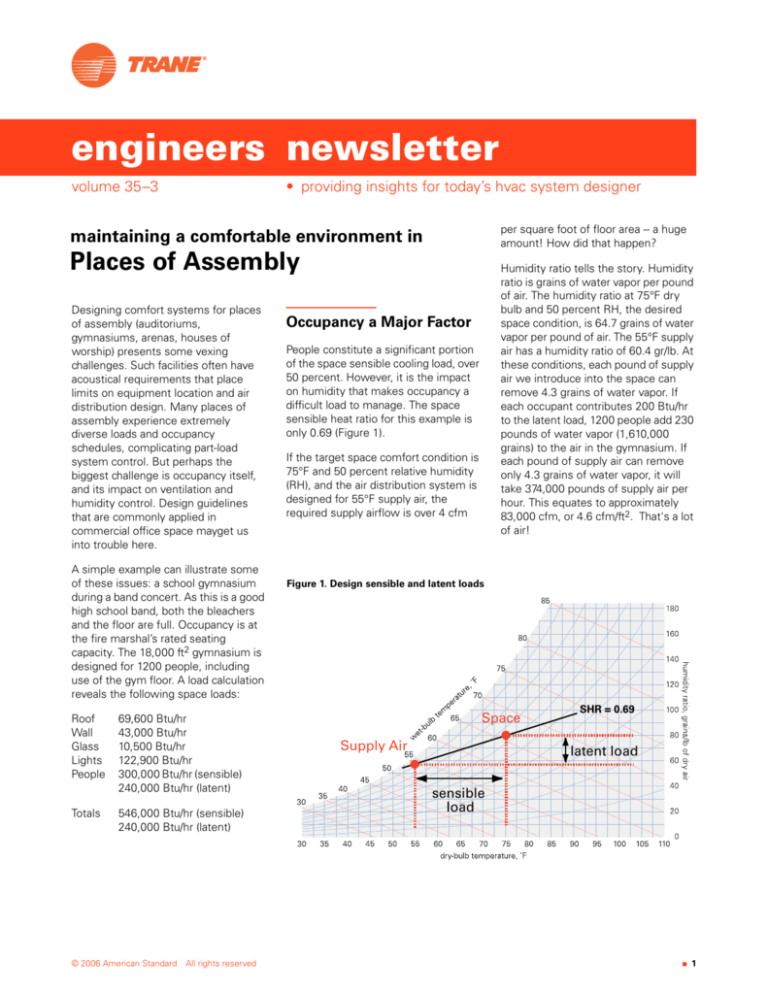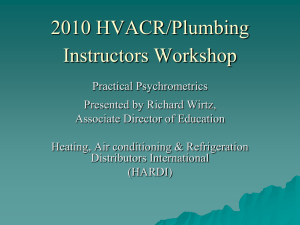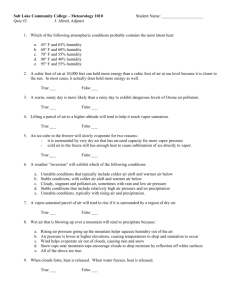
engineers newsletter
volume 35–3
• providing insights for today’s hvac system designer
per square foot of floor area -- a huge
amount! How did that happen?
maintaining a comfortable environment in
Places of Assembly
Designing comfort systems for places
of assembly (auditoriums,
gymnasiums, arenas, houses of
worship) presents some vexing
challenges. Such facilities often have
acoustical requirements that place
limits on equipment location and air
distribution design. Many places of
assembly experience extremely
diverse loads and occupancy
schedules, complicating part-load
system control. But perhaps the
biggest challenge is occupancy itself,
and its impact on ventilation and
humidity control. Design guidelines
that are commonly applied in
commercial office space mayget us
into trouble here.
A simple example can illustrate some
of these issues: a school gymnasium
during a band concert. As this is a good
high school band, both the bleachers
and the floor are full. Occupancy is at
the fire marshal’s rated seating
capacity. The 18,000 ft2 gymnasium is
designed for 1200 people, including
use of the gym floor. A load calculation
reveals the following space loads:
Roof
Wall
Glass
Lights
People
69,600 Btu/hr
43,000 Btu/hr
10,500 Btu/hr
122,900 Btu/hr
300,000 Btu/hr (sensible)
240,000 Btu/hr (latent)
Totals
546,000 Btu/hr (sensible)
240,000 Btu/hr (latent)
© 2006 American Standard
All rights reserved
Humidity ratio tells the story. Humidity
ratio is grains of water vapor per pound
of air. The humidity ratio at 75°F dry
bulb and 50 percent RH, the desired
space condition, is 64.7 grains of water
vapor per pound of air. The 55°F supply
air has a humidity ratio of 60.4 gr/lb. At
these conditions, each pound of supply
air we introduce into the space can
remove 4.3 grains of water vapor. If
each occupant contributes 200 Btu/hr
to the latent load, 1200 people add 230
pounds of water vapor (1,610,000
grains) to the air in the gymnasium. If
each pound of supply air can remove
only 4.3 grains of water vapor, it will
take 374,000 pounds of supply air per
hour. This equates to approximately
83,000 cfm, or 4.6 cfm/ft2. That's a lot
of air!
Occupancy a Major Factor
People constitute a significant portion
of the space sensible cooling load, over
50 percent. However, it is the impact
on humidity that makes occupancy a
difficult load to manage. The space
sensible heat ratio for this example is
only 0.69 (Figure 1).
If the target space comfort condition is
75°F and 50 percent relative humidity
(RH), and the air distribution system is
designed for 55°F supply air, the
required supply airflow is over 4 cfm
Figure 1. Design sensible and latent loads
Space
Supply Air
SHR = 0.69
latent load
sensible
load
●
1
This 25,000 cfm of supply air equates
to 1.4 cfm/ft2. This is a large, but
manageable supply air quantity. But we
still need 83,000 cfm of supply air to
control humidity. How do we better
equip the supply air to handle the high
latent load associated with this many
people? Obviously the supply air needs
to be drier. The drier the supply air (the
lower the dew point), the more water
vapor it will remove from the space.
What supply air dew point is required
to handle the space latent load?
*While many local codes may still require 15 cfm/
person for ventilation, the most recent version of
ASHRAE Standard 62.1-2004 has revised the
minimum required ventilation rates for places of
assembly.
Calculating Specific Humidity. The
key is another humidity measurement
called specific humidity. Specific
humidity is expressed as pounds of
water vapor per pound of air. Suppose
we choose to design the air distribution
system for our example gymnasium for
25,000 cfm (114,000 pounds per hour).
The 1200 people generate 227 pounds
of water vapor each hour. Removing
227 pounds of water vapor with
114,000 pounds of air requires that the
specific humidity of the supply air be
0.0020 lbw/lba drier than the space.
The specific humidity at 75°F and 50
percent RH is 0.0092 lbw/lba. So the
specific humidity of the supply air must
be 0.0072 lbw/lba to offset the latent
load of the people. This corresponds to
a supply air dew point of about 48°F.
2
●
Trane Engineers Newsletter volume 35–3
that is able to regenerate at low
temperatures, often without the need
to add heat. This allows the wheel to
be configured in series with a cooling
coil. This activated alumina desiccant
wheel is available in a Trane system
called CDQ™ (Cool, Dry, Quiet).2 The
addition of the CDQ wheel allows the
system to deliver supply air at 48°F
dew point, while the cooling coil only
needs to cool the air to 54°F. With CDQ
there is no need to design a cold air
distribution system. Since there is no
need to produce 50°F supply air, the
required capacity of the cooling load is
substantially reduced.
So how do we create this 48°F dew
point supply air? One common method
is to cool all the supply air to a dry-bulb
temperature of about 49°F to 50°F. This
should dehumidify the supply air to the
48°F dew point required to offset the
latent load due to people.
Supplying 50°F air to the gymnasium
provides additional benefits. It reduces
the required airflow needed to offset
the space sensible cooling load from
25,000 cfm to only 20,000 cfm (1.1
cfm/ft2). This concept is called cold air
distribution, and is a common design
approach when aggressive humidity
control is required or the design team
is seeking ways to reduce fan power or
air handler footprint.1 All of these
benefits may be attractive when
designing for places of assembly. Cold
air also requires careful diffuser
selection, careful temperature control,
and reliable control of building
pressure. In addition, supply-air
temperatures below 50°F may
preclude the use of conventional,
direct expansion (DX) equipment.
With the cold air system, the required
cooling coil capacity is about 150 tons
(based on 1200 people and 18,000 cfm
of outdoor air) and supply fan power is
only 10 kW. The CDQ system reduces
cooling coil capacity to about 140 tons,
but increases fan power to 16 kW
because of the higher airflow and
additional static pressure from the
desiccant wheel. Both are viable
options. It is noteworthy that CDQ may
be an excellent means to achieve low
supply air dew points with
conventional DX equipment.
The Desiccant Approach. But do we
need colder air, or do we need drier air?
The truth is, we don't need air that is
colder; we only need air that is drier.
Recent research in desiccants has
resulted in a Type III desiccant wheel
Don't Forget Part Load Situations.
Places of assembly often experience
very diverse loads. It would be wise to
evaluate the performance of these
Figure 2. Air handling unit with a Type III series desiccant wheel (Trane CDQ)
OA
83° F DB
71° F DP
Coil
60° F DB
59° F DP
Cooling coil
WATER VAPOR
Humidity is the Driver.
In this example, 83,000 cfm is required
to handle humidity, but only 18,000
cfm of this must be outdoor air for
ventilation (assuming 15 cfm of OA per
person*). With a space sensible
cooling load of 546,000 Btu/hr and a
supply-air temperature of 55°F;
approximately 25,000 cfm is required
to maintain the space temperature at
75°F. In this case, 72% of the supply air
must be outdoor air. While this is a
high fraction of outdoor air, it is
manageable. Ventilation air is not the
culprit.
89° F DB
68° F DP
RA
65° F DB
55° F DP
SA
Trane CDQ desiccant wheel
providing insights for today’s HVAC system designer
systems at part load. There are two
part-load conditions we should
evaluate. One is quite obvious, which is
what happens when most of the
people leave. Perhaps the remaining
occupancy is only 40 people instead of
1200. This is an easy part-load
condition to accommodate. The
sensible loads drop to 256,000 Btu/hr
and the latent load due to people drops
to only 8000 Btu/hr. The resulting
space sensible heat ratio increases to
0.97.
If we supply air at 50°F with the cold air
system, the required supply airflow is
only 9400 cfm. This system is called
"single zone VAV." Supply airflow is
reduced to match the reduced sensible
cooling load in the space. Single zone
VAV is easy to control. The supply fan
airflow is modulated based on space
temperature. The 9400 cfm of 50°F air
will remove the 256,000 Btu/hr of
sensible heat and has the potential to
remove 116 pounds of water vapor.
However, at this reduced occupancy,
the people add only 7.6 pounds of
water vapor. The result is that space
humidity is lowered to 40 percent RH.
At this condition, the supply-air
temperature could be reset upward to
save some compressor energy.
Problem with Constant Volume
Systems. What happens if the cold air
system is a constant volume design
rather than VAV? The reduced sensible
cooling load requires a warmer supplyair temperature, about 63°F for this
example. At this supply-air
temperature, the 20,000 cfm of supply
air will remove 256,000 Btu/hr of
sensible heat, but less than 7.6 pounds
of water vapor. Space humidity rises to
65 percent RH, well above our target of
50 percent. Not only does a constant
volume system use more fan energy at
part load, but it is less adept at
removing moisture. By comparison, a
single zone VAV system reduces fan
energy while adequately removing
moisture. Single zone VAV with cold air
provides humidity control at most load
providing insights for today’s HVAC system designer
conditions, while simultaneously
saving fan energy.
without reheat, when all envelope
conduction and solar loads are absent.
How does CDQ fare with reduced
occupancy? If the supply fan delivers a
constant volume of air, the reduced
sensible load requires the supply-air
temperature to increase to over 65°F.
However, the CDQ desiccant wheel
can still deliver the supply air at 55°F
dew point (Figure 2). The resulting
space humidity rises to only 52 percent
RH. Constant volume CDQ is certainly
adept at controlling space RH at lower
occupancy, but the benefits of VAV can
be applied to CDQ systems too.
Both cold air and CDQ systems
perform well at this part-load condition.
Single zone VAV results in a slightly
elevated space relative humidity, but
still well within the comfort zone. This
comfortable condition is achieved
without reheat and uses less fan
energy. Some reheat and additional fan
energy may be needed if more precise
humidity control is desired.
When Sensible Loads are Lighter.
There is another part-load condition
that can be even more sinister;
reduced building-related sensible loads
while the space is fully occupied. What
happens with full occupancy (1200
people) when there is envelope or
glass loads? If the only loads in the
space are due to lighting and people,
the sensible heat ratio drops to 0.63. If
we dim the lights, the situation gets
even worse.
Each Situation Unique. Well, it was a
great concert, but this was a high
school concert band, not a rock band.
Add smoke from a pyrotechnic display,
or moisture from an Olympic size
swimming pool, and designing a
comfort system for "places of
assembly" can be even more
challenging. In addition to reheat, cold
air distribution and the CDQ desiccant
wheel, give us additional tools to deal
with high space latent loads. Simple
airside control schemes like single
zone VAV provide an easy means of
adapting to diverse part-load conditions
while providing some energy savings.
Table 1. System comparison at part load (no envelope conduction or solar loads)
This reduction in the space sensible
cooling load creates a sensible heat
ratio more severe than what the
system was originally designed to
accommodate. Increasing the supplyair temperature or reducing supply
airflow in response to the reduced
sensible load will hinder the ability to
remove moisture. Reheat can help
when the sensible heat ratio is lower
than design. Both cold air and CDQ
have the ability to reduce sensible
cooling capacity while maintaining a
lower supply air dew point. Table 1
compares these systems, with and
Article by Don Eppelheimer, applications
engineer,Trane. You can find this and previous
issues of the Engineers Newsletter at
www.trane.com/engineersnewsletter. To
comment, e-mail comfort@trane.com.
1.A
2000 Engineers Newsletter (volume 29-2,
"Cold Air makes Good $ense") provides more
detail on the benefits and design issues related
cold air distribution systems.
2A
2005 Engineers Newsletter (volume 34-4,
"Advances in Desiccant-Based Dehumidification")
provides more detail on the series configuration of
a Type III desiccant wheel (Trane CDQ).
Trane Engineers Newsletter volume 35–3
●
3
4
●
Trane Engineers Newsletter volume 35–3
providing insights for today’s HVAC system designer
Trane
A business of American Standard Companies
www.trane.com
For more information, contact your local Trane
office or e-mail us at comfort@trane.com
Trane believes the facts and suggestions presented here to be accurate. However, final design and
application decisions are your responsibility. Trane disclaims any responsibility for actions taken on
the material presented.
5
●
Trane Engineers Newsletter volume 35–3
ADM-APN021-EN (September 2006)
6
●
Trane Engineers Newsletter volume 35–3
providing insights for today’s HVAC system designer






